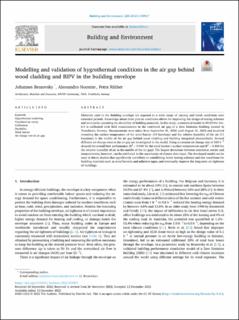| dc.contributor.author | Brozovsky, Johannes Georg | |
| dc.contributor.author | Nocente, Alessandro | |
| dc.contributor.author | Rüther, Petra | |
| dc.date.accessioned | 2022-12-16T08:08:50Z | |
| dc.date.available | 2022-12-16T08:08:50Z | |
| dc.date.created | 2022-12-13T07:30:52Z | |
| dc.date.issued | 2022 | |
| dc.identifier.issn | 0360-1323 | |
| dc.identifier.uri | https://hdl.handle.net/11250/3038146 | |
| dc.description.abstract | Materials used in the building envelope are exposed to a wide range of varying and harsh conditions over extended periods. Knowledge about these precise conditions allows for improving the design of testing schemes and eventually extending the durability of building materials. In this study, a numerical model in WUFI-Pro Ver. 6.5 is calibrated with field measurements in the ventilated air gap of a Zero Emission Building located in Trondheim, Norway. Measurements were taken from 01.09.2020 until 31.08.2022 and involved recording the surface temperature of the wind barrier (19 locations) and the relative humidity of the air (11 locations) in the middle of the air gap behind wood cladding and building integrated photovoltaics. Several different air change rates in the air gap are investigated in the model. Using a constant air change rate of 100 h-1 showed the overall best performance (R2 = 0.940 for the wind barrier’s surface temperatures and R2 = 0.806 for the relative humidity of air in the middle of the air gap). The largest deviations between simulation results and measurements, however, can be attributed to the uncertainty of climate data input. The developed model can be used in future studies that significantly contribute to establishing better testing schemes and test conditions for building materials such as wind barriers and adhesive tapes, and eventually improve the long-term air tightness of buildings. | en_US |
| dc.language.iso | eng | en_US |
| dc.publisher | Elsevier | en_US |
| dc.relation.uri | https://doi.org/10.1016/j.buildenv.2022.109917 | |
| dc.rights | CC BY 4.0 | * |
| dc.rights.uri | http://creativecommons.org/licenses/by/ | * |
| dc.subject | Hygrothermal modelling | en_US |
| dc.subject | Ventilated air cavity | en_US |
| dc.subject | Calibration | en_US |
| dc.subject | Durability | en_US |
| dc.subject | Wind barrier | en_US |
| dc.subject | Air change rate in air gap | en_US |
| dc.title | Modelling and validation of hygrothermal conditions in the air gap behind wood cladding and BIPV in the building envelope | en_US |
| dc.type | Peer reviewed | en_US |
| dc.type | Journal article | en_US |
| dc.description.version | publishedVersion | en_US |
| dc.rights.holder | © 2022 The authors. | en_US |
| dc.source.volume | 228 | en_US |
| dc.source.journal | Building and Environment | en_US |
| dc.identifier.doi | 10.1016/j.buildenv.2022.109917 | |
| dc.identifier.cristin | 2092309 | |
| dc.relation.project | Norges forskningsråd: 245663 | en_US |
| dc.relation.project | Norges forskningsråd: 237859 | en_US |
| dc.relation.project | Norges forskningsråd: 294894 | en_US |
| dc.source.articlenumber | 109917 | en_US |
| cristin.ispublished | false | |
| cristin.fulltext | original | |
| cristin.qualitycode | 2 | |

